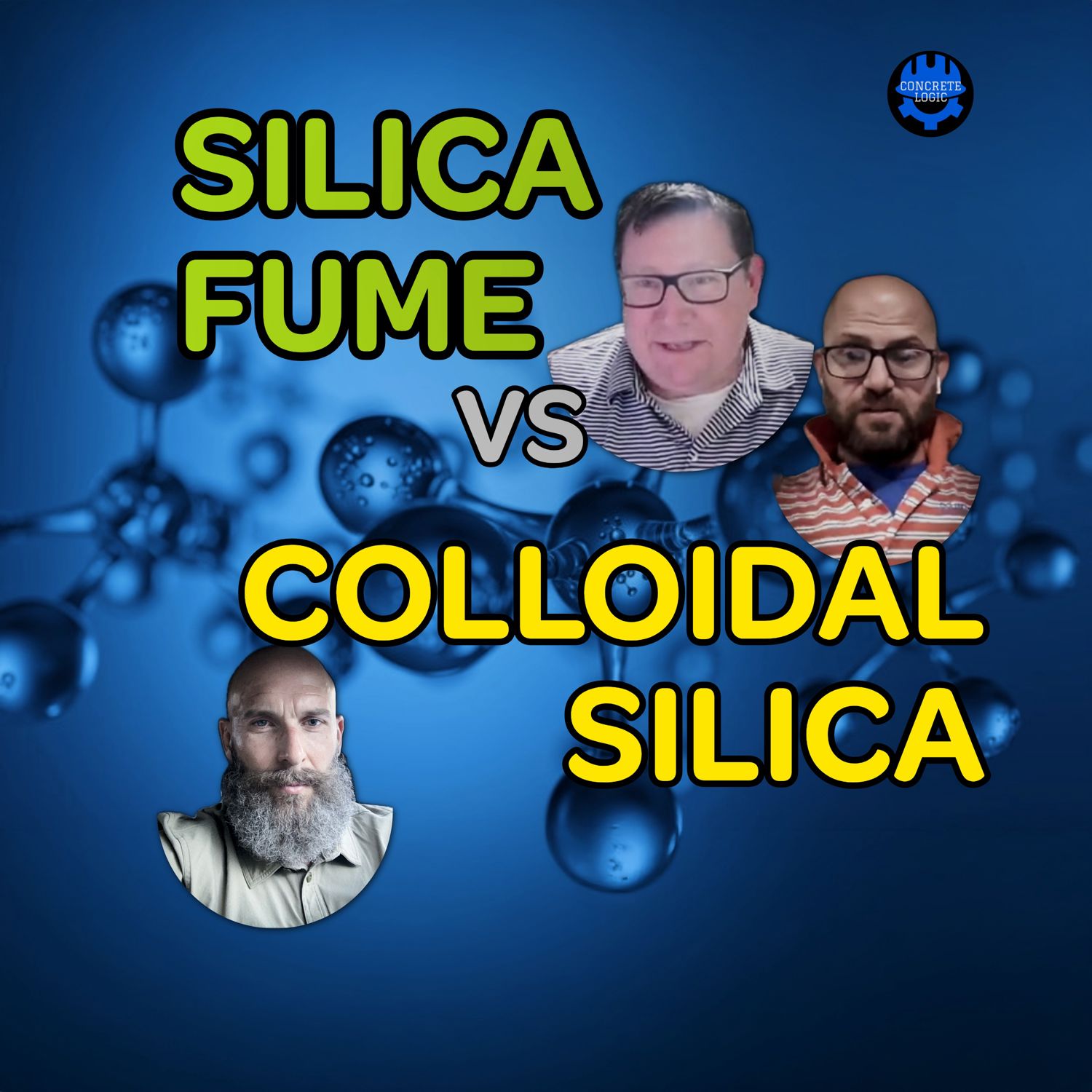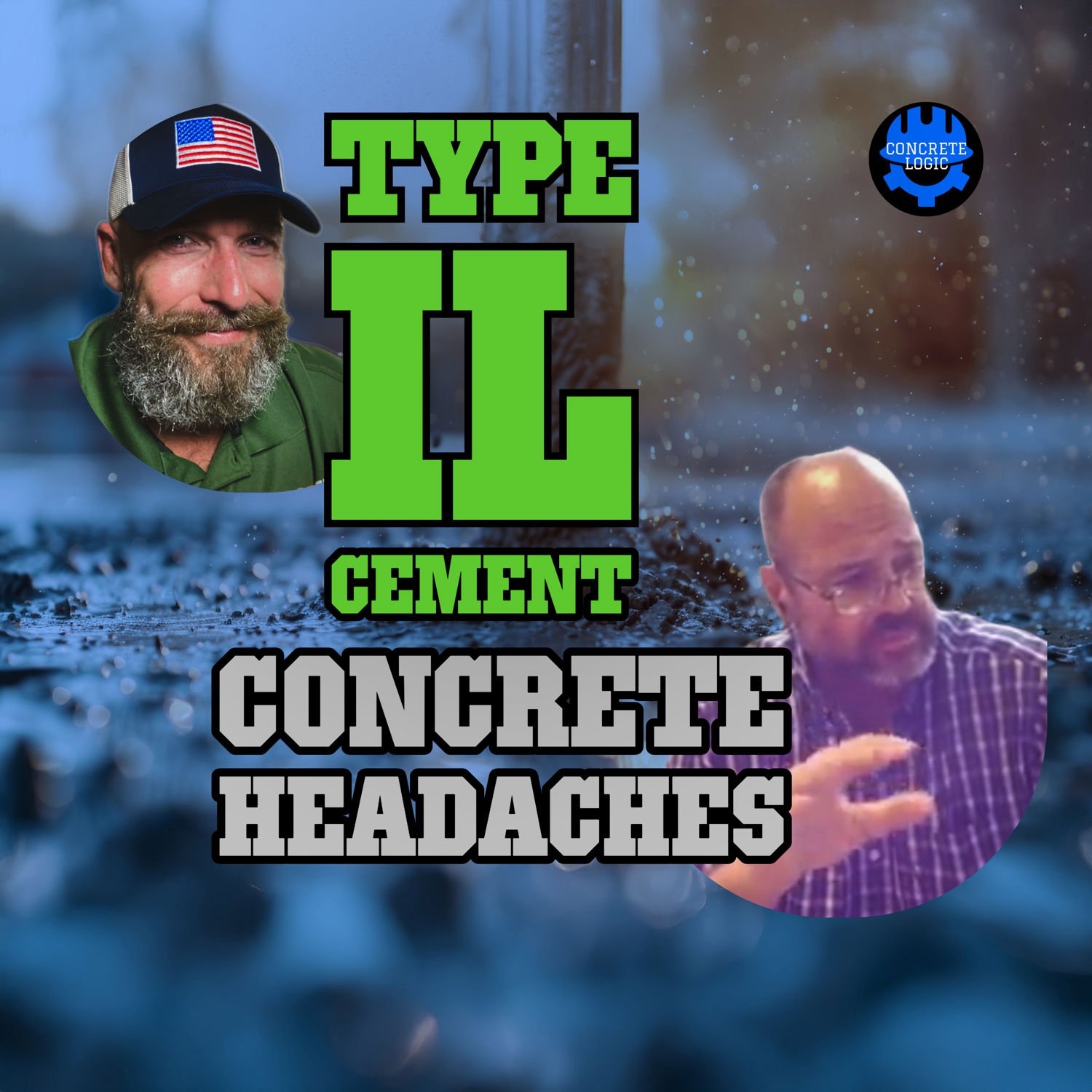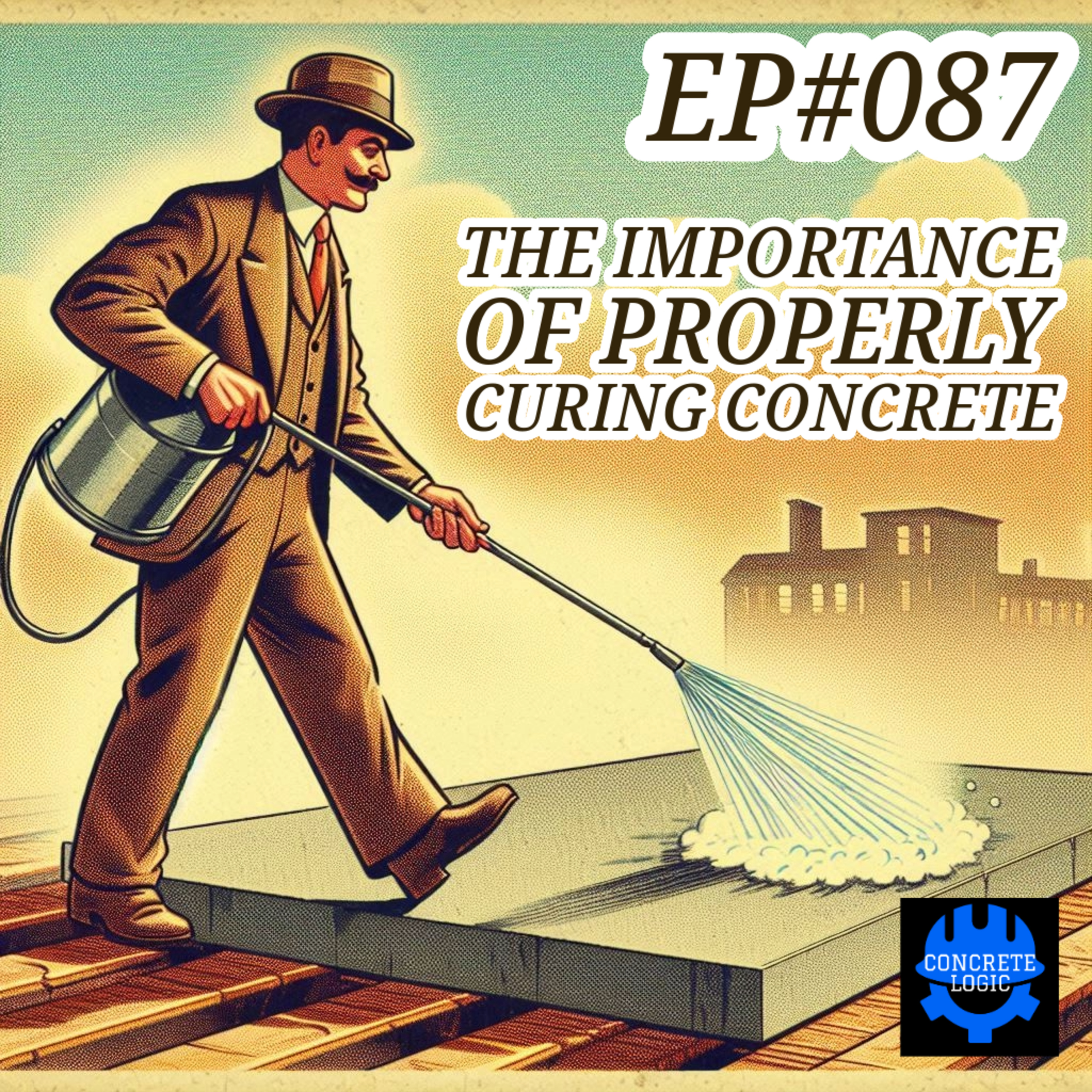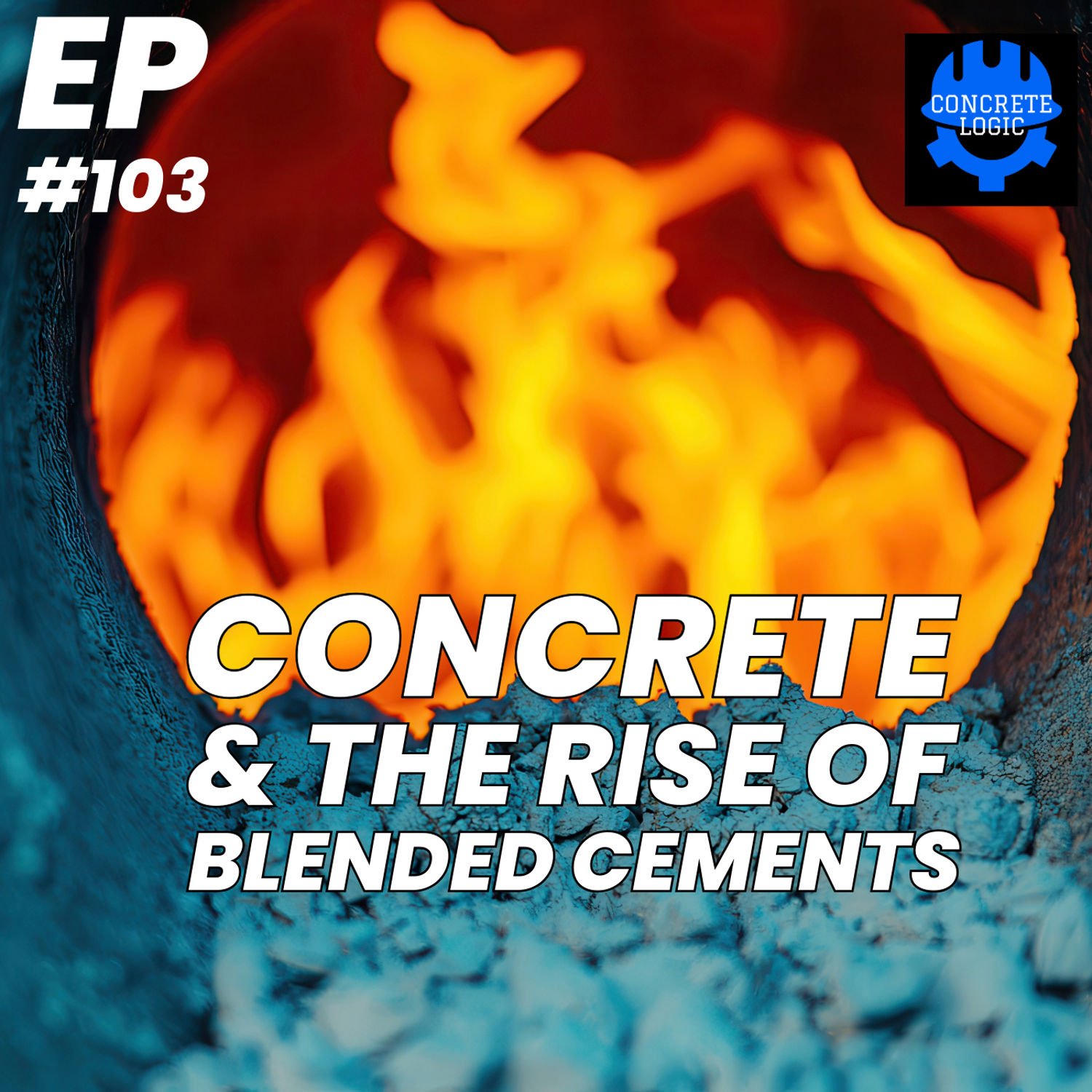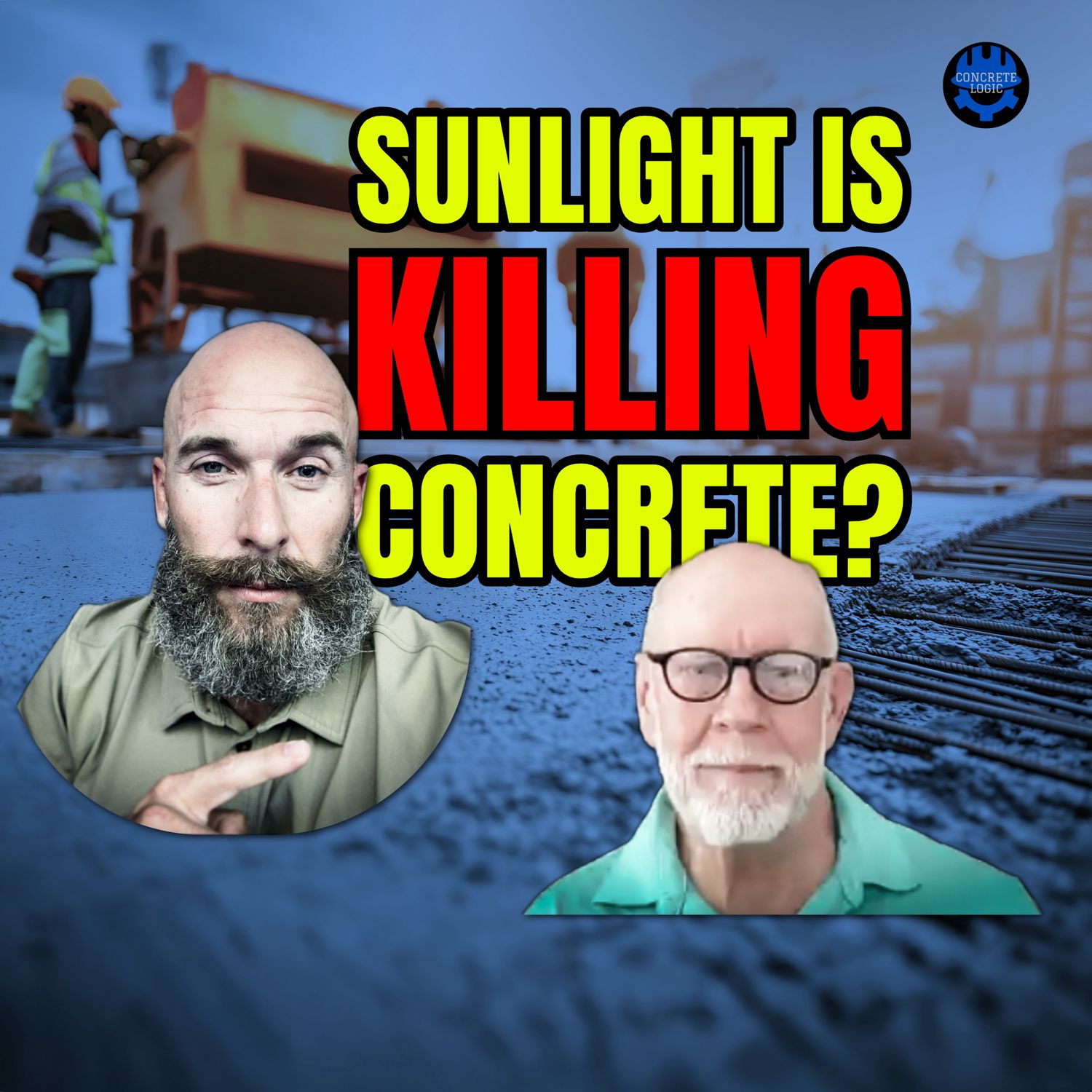EP #125: Hot Weather, Hot Mess — The Hidden Dangers of Pouring Concrete in High Temperatures

Most contractors think warm weather helps speed up a pour—but what if that early strength is fooling you?
In this episode of the Concrete Logic Podcast, host Seth Tandett is joined again by concrete chemist Bob Higgins to break down the real effects of high temperatures on concrete strength, durability, and long-term performance. They cover new science on curing, the shocking impact of temperature on cement hydration, and why most current standards are dangerously outdated.
If you’re pouring slabs in hot weather, this episode could save your project—and your reputation.
What You'll Learn in This Episode:
- Is your summer concrete secretly sabotaging long-term strength?
- What actually happens to cement hydration when concrete gets too hot?
- Can high early strength be misleading—and even dangerous?
- Why is the surface of your slab the weakest link in hot weather pours?
- What’s the truth about internal curing and how can it save your concrete?
- How does curing temperature affect concrete performance a year later?
- Are old curing standards putting your concrete projects at risk?
- Can insulation blankets and self-curing mixes solve the heat problem?
CHAPTERS:
00:00 Intro – Four Questions Every Contractor Should Ask
02:00 Why Heat Hurts Concrete More Than You Think
06:00 Explaining the Graphic: Temperature vs Long-Term Strength
11:30 Surface Damage: The 1-Inch Problem
14:00 What Curing Really Does—and What It Doesn't
17:30 Internal Curing vs Wet Curing
22:00 Misting, Self-Curing Aggregates, and Propylene Glycol
26:00 The Real Reason Roads Fail After 10 Years
30:00 Final Thoughts: Don’t Pour in the Heat Without a Plan
Guest: Robert "Concrete Bob" Higgins | RC Consulting
Email: rcconsulting.higgins@gmail.com
Website: https://www.concretelogicpodcast.com/guests/robert-higgins/
=============================
Take Your Knowledge Further – Join Concrete Logic Academy!
Gain access to expert video lessons, live Q&As, and professional development hours (PDHs). Learn what the textbooks won’t teach you.
Start Learning: https://www.concretelogicacademy.com
Support the Podcast – Be Part of the Concrete Revolution!
Help us keep the Concrete Logic Podcast going strong. Your donation helps the entire concrete community get better and smarter.
Donate here: https://www.concretelogicpodcast.com
Want your company to sponsor the podcast? Learn how: https://www.concretelogicpodcast.com/p/partner-with-concrete-logic-podcast/
Producer: The Fricks Company (www.fricksco.com), Jodi Tandett
Music by: Mike Dunton (Instagram: @Mike_Dunton)
Stay Connected & Watch More!
Host: Seth Tandett
Email: seth@concretelogicpodcast.com
LinkedIn: https://www.linkedin.com/in/seth-tandett/
YouTube: https://www.youtube.com/@concretelogicpodcast
Website: https://www.concretelogicpodcast.com
LIKE, SUBSCRIBE, COMMENT & SHARE for more concrete truth bombs.
00:26 - Intro – Four Questions Every Contractor Should Ask
02:26 - Why Heat Hurts Concrete More Than You Think
06:26 - Explaining the Graphic: Temperature vs Long-Term Strength
11:56 - Surface Damage: The 1-Inch Problem
14:26 - What Curing Really Does—and What It Doesn't
17:56 - Internal Curing vs Wet Curing
22:26 - Misting, Self-Curing Aggregates, and Propylene Glycol
26:26 - The Real Reason Roads Fail After 10 Years
30:26 - Final Thoughts: Don’t Pour in the Heat Without a Plan Guest: Robert "Concrete Bob" Higgins | RC…
Seth Tandett (00:00)Welcome to another episode of the Concrete Logic Podcast. And today I have Concrete Bob Higgins with me. And today, there's four things we were going to cover today. How do high temperatures affect the molecular structure of concrete? What changes occur in concrete strength and durability when exposed to extreme heat?What can contractors do to minimize the negative effects of heat on concrete during pours? And lastly, how can understanding the science behind concretes performance and hot climates lead to better construction practices? And when Bob is on the podcast, we always talk about the science of concrete and the chemistry of concrete. And we're going to do so again today. So Bob, do you want to?get started here and let's just talk about how the high temperatures impact concrete.Robert Higgins (00:49)Okay, thank you Seth. High temperatures have always been considered favorable to contractors because it really speeds up the scheduling. But unfortunately, as the case is with almost everything we do, speed is everything and it can be somebody else's problem down the line.The worst possible condition for concrete during its time of curing is to be exposed to high temperatures, especially in direct sunlight and elevated temperatures where it can hit 120, 130 degrees on the surface. What happens is there's a lot of things that go on where the...chemical reactions accelerate, but they're not being addressed by current studies or even older studies. I have gone back to these studies 40, 50 years and moved forward and I cannot find anything that will directly address what's causing it. There was one nibble on the corner where it said, with these high performance concretes, because of cement formation, it consumes too much water, so it self-desiccates.Well, that's all well and good but that's not the entire reason because if you if For concrete to self desiccate to the point where it won't form more cement the relative humidity in In that area where the cements not forming has to fall below 80 % Now even at 80 % which is a minimum that that's only about a 10 % efficiency and cement development. So if anythinghappens where it drops below 80%, cement formation stops. Now the critical point here is when it stops, there's a lot of it that isn't recoverable. So the damage is permanent. So everything that's done at time of cure is not done correctly or adjusts properly to the environment, especially with heat.I'll go into some of the details of that. But heat damages almost everything in the curing process. Because if you look at steam curing of concrete precast and pre-stressed, steam curing gives it very good early strength. The problem is it makes the surface extremely permeable.They've been trying the last 30 years to make the concrete less permeable with very limited success. Well, it's not going to, no matter what they do, it's not going to help unless they do something additionally to treat the surface of the concrete because they've interrupted the cement formation with the elevated heat. And from what I've understood with concrete,forms its cement when the byproducts is calcium hydroxide. Well, that makes up upwards of 15 % of the hydration products. But what happens with calcium hydroxide, as it gets warmer, it becomes insoluble. Well, part of that's on that particle. you have the unhydrated clinker.And then it heats up, then wherever the calcium hydroxide is present, it's not going to allow the water to engage the particle because it's insoluble. It doesn't take the water on any longer. And as it keeps heating it up, it gets more more resistant. And at about 100 degrees Fahrenheit, calcium hydroxide, for all intents and purposes, is completely insoluble.So it won't take on the moisture. But that's only one aspect of it. As it heats up, we're finding out that not just heat, but light itself can increase the evaporation of water, which that was a recent discovery by MIT over the last year.And that's been verified by peer review by four other researchers. And what happens then is it's the lowering the moisture content in the concrete, it increases the alkalinity. Now, this is the one that bothers me. No one is looking at the alkalinity. And I keep asking them, why aren't you engaging this? They look at the mechanics, but not the chemistry. When?And there's no exception to this. When the alkalinity, such as sodium hydroxide, which is present in regular Portland cement and what cement kiln does, that's the primary alkaline material. As it gets concentrated, it lowers the relative humidity. There's a reciprocal lowering of the relative humidity.And as it lowers, if it gets below 80%, cement formation stops. And that's been established since the 1940s and 1950s. Why don't we put up that first graphic showing what temperature does to the concrete.Seth Tandett (05:05)OK.Robert Higgins (05:06)There it is. Now, the reason why they don't like it when it's cold is because at 55 degrees at 28 days, the concrete's only going to reach 43 % of its intended compressive strength at 28 days.The upside is if you keep it cool like that, the concrete strength will exceed what the targeted values are at 365 days. Now the importance of this graphic, the blue where it says day one, that day one is at 28 days. That's what happens. There's the strength that you have of the concrete at 28 days. And the red graphic is the strength at 365 days. Now the issue with thisand why this is so important to contribute to the emphasis of how damaging and irreversible this process is. The red designation...That's where concrete was kept in a 73 degree chamber at 100 % relative humidity for the remainder of the year. So past the 28 days, the remainder of the year was kept in a 100 % relative humidity. And if you look at 120 degree Fahrenheit, they only recovered 73 % of the strength. It couldn't get to 100%. Now this is a best case scenario.This won't happen in the field because it's not going to 100 % relative humidity or stay that cool all the way around. It's going to be much worse than this.Seth Tandett (06:31)Right.Or better, right? Because that, so I guess we need to explain a little bit for folks that are just listening and are not watching on YouTube. The first column there, it says 55 degrees. And day one you're saying it's going to reach, â in 28 days the blue bar representsthe strength that it'll reach at 28 days, right? So that it'll reach 43 % of design strength. And if you keep it at that temperature for 365 days, it will reach 110%. Is that the right way to read this?Robert Higgins (07:01)That's correct.No, â each one of the red bars represents when they put the sample in the environmental chamber at 73 degrees, 100 % relative humidity. Yeah. Yeah.Seth Tandett (07:27)okay, yeah, I see that it's on the side there. All right,so 73 degrees after the initial curing. And how long is it? So it's just one day at 55 degrees. Is that right?Robert Higgins (07:40)No,it's all 28 days. It's 28 days, but that's from day one. That's their day one start. What was the value at 28 days? That's your day one. Then the remainder of the year, the 365 days, they put all these samples in the same environmental chamber and they compared the strength for what its targeted value was at 365 days.Seth Tandett (07:43)Okay.Okay, alright.Okay, so day one, 55 degrees. Rest of the 28 days, 73 degrees. Sorry.Robert Higgins (08:10)No, 28 days at 55, 28 days at 73, 28 days at 90 degrees. These are showing you the effect of temperature while the concrete's curing. The day one is at the end of the 28 days. Yeah, it's a confusing graphic. I had to go through this with the source that gave me the graphic. said, this is a little convoluted the way it's a little too.Seth Tandett (08:17)Okay.Okay.I gotcha. Alright, I'm hearing you.Robert Higgins (08:36)It's too short to really explain what it's doing. So when it was finally explained to me, said, OK, now I get it. So they took all these samples, stuck them in this environmental chamber at 73 degrees, passed the 28 days for the remainder of the year. And these are the strengths that they got at the end of that year.Seth Tandett (08:54)I gotcha.Yeah. So the first one's 55 degrees. So it will only reach 43 % of the strength in 28 days and 365 days it'll reach 110%. Okay. And then 73 degrees looks to be the ideal temperature because it's a hundred percent, a hundred percent. 90 degrees initial.Robert Higgins (09:06)for it.correct.Correct.Seth Tandett (09:22)strength at 28 days is 127 % which gets everyone excited right?Robert Higgins (09:28)Exactly, they think it's going to get better concrete because it's stronger at 28 days and that's the mindset. Now look at that. There's our mindset. From there on, look at the benefit.Seth Tandett (09:34)Yeah, and, yep. Yeah.So at three, after a year, if the initial temperature is 90 degrees, the curing ambient temperature is what we're talking about. It'll be 90 % of design strength. And then at the next bar is 105 degrees.Robert Higgins (09:52)Yes.Seth Tandett (10:01)So after 28 days at 105 degrees, the strength will reach 150%, which everybody would be excited about. But then after a year, the strength drops to only 82 % of design strength. And then the last one, it says 120 degrees. And that will, after 28 days, reach 200 % of design strength.but after a year, it will be only 73 % of design strength.Robert Higgins (10:32)Correct, and that's in an environmental chamber that remains at 100 % relative humidity. That won't happen in the field. These numbers will be farther apart. The concrete will be, it would probably be more like 50 % or even 45 % of where it should be at the end of a year.Seth Tandett (10:39)Right.Okay. âRobert Higgins (10:52)So you'vegot, but that loss is towards the surface of the concrete, not all the way through the concrete because in through the concrete, it's not going to get that hot. It's only in the gradient portion of the concrete.That's really important to note. The gradient portion of the concrete reaches in about an inch. That seems to be consistent globally, because the Middle East studies I saw, the Chinese studies I saw, and another study I saw in Portugal, they all zeroed in on between 3 quarters of an inch to one inch of the surface is consistently the gradient.Seth Tandett (11:29)When you say gradient, that mean, what do you mean by that?Robert Higgins (11:33)That's the surface of the concrete. The top surface is what's being affected. if it's, so the surface of the concrete's permeable, it absorbs things. It absorbs things you don't want it to absorb, like water and other things in there, such as de-icing salts, pick something.it allows easy entry of any waterborne material. So therein lies the weak link in the whole chain of concrete. So if we go to the next one, Dr. Zollinger, this will really â emphasize this. Now Dr. Zollinger's graphic is, that's with Texas Transportation Institute. So this was a federally funded program. And it's fascinating.Because he's the first â researcher I've ever seen that actually isolated the gradient portion of the concrete. Now, if you look, it has no curing. The compressive strength still hits 4,000 psi. The 7-day wet cure, it also hits 4,000 psi. But the big difference is, with no curing, the compressive strength in the first top inch is only 2,800 psi.But even with a water cure, a 7-day water cure, which is considered optimal, it's only 3,200 PSI. Now, you say, well, how does that happen? That doesn't reflect in the compression strength test. Well, the compression strength test doesn't tell you if anything crushes. only registers at time of break. So it will miss this completely. We're actually skipping over.the analysis of the top surface of the concrete. So when he sliced off that top inch and found that it was only 3,200 PSI, that again correlates with what the other studies were showing with the â concrete gradient and the temperature damage that it has in the concrete. So curing is so...not just underrated, it's just not being done correctly because the curing standards were developed over 100 years ago and they haven't changed a lot. Concrete and cement chemistry have changed profoundly since then.But we have not kept pace with that. Because everybody wants to do it the same way they've always done it. It's like when they introduced type 1L cement. Well, it's a one for one with type 1, type 2 cement. Well, no, wasn't. So now they're making all these adjustments because now you've changed the chemistry, things are reacting differently. Now, if people have known ahead of time how to compensate for that, that's fine. But we're not even compensating for the old standard.We haven't compensated. All these changes are going on in concrete that we haven't compensated for, but it's good enough. Well, it's not good enough. The concrete should last decades without damage.Seth Tandett (14:25)Okay, so, so, yeah.So this graphic for folks that are listening, there's a, on the left half of the slide, it says no carrying compressive strength will reach 4,000 below one inch of the surface and 2,800 at that first one inch.And then the second part of the slide says, if you do a seven day wet cure, the compressive strength again will reach 4,000 below one inch of the surface, but that initial one inch will only reach 3,200. So what we learned from this is no curing or seven day wet curing.that one inch is still not reaching design strength, that initial â one inch. So what would happen if we, â what is this telling us Bob? If we just insulate the concrete without a wet cure, like protect the surface of the concrete, could we?Robert Higgins (15:33)Basically,what we have to do is the concrete industry needs to move towards self-curing concrete. That's really the only way to deal with this.Seth Tandett (15:36)huh.Right. Well, I was thinkingtoo. mean, if you don'tOkay, I want to go back to the other slide. I'm going to throw you off here. All right, let's go back to this other screen.Robert Higgins (15:51)Yeah, no problem.If you start dissecting this, you're realizing, wow, look at what we're doing wrong.Seth Tandett (16:00)Yeah, okay. So we're back to the slide where the effects of curing, the occurring temperature on concrete streets. And again, we're talking about ambient temperature. We're not talking about the temperature of the concrete itself. So just want to make sure everyone's on the same page. All right, so we're looking at this graphic again and the cold temperature. âRobert Higgins (16:11)Other things.Hmm.Seth Tandett (16:25)The cooler temperatures, it seems to be what the concrete prefers, the 55 and the 73 degree. So I guess, again, just thinking this at this, I know we like internal curing. We've talked about that plenty of times on here. But is another option is,Is it just to maintain the temperature that the concrete is â experiencing? So if let's just saygoing back to a past episode with you that we've done, we were talking about how if we condition the space â before we apply flooring, that is the ideal situation, right? And you give it the concrete likes that and the flooring likes that and the adhesive likes that. Is that the same thing that â in this?If we could cure concrete, say you condition the space before you pour a slab and get it to 73 degrees and keep it at 73 degrees, wouldn't that be the same way without doing an internal cure or no cure?Robert Higgins (17:28)Yeah, damn it.Yeah, I believe that we would get a really, really good concrete if we can control the environment. Now you just have to make sure that the water doesn't evaporate. Now there's the other issue is concrete is more alkaline than it used to be. And if you get any water loss and the relative humidity in the surface drops, that's the concern we have. Now when you talked about the insulation that got my mind working, I had thought about that. But if we could somehow put like aSeth Tandett (17:43)Right.Robert Higgins (18:00)Insulate a blanket on there. That's temperature control You keep the concrete wet you put that down and it keeps the concrete at 70 degrees You'd have a really really good piece of concrete because there's no reason for it to â Self desiccate at that point because it's not losing any water if there's no heat gradient There's no there's no gradient to the concrete. It's just consistent all the way through wants to move to the cool sideSeth Tandett (18:29)Yeah,Robert Higgins (18:29)So let's move down.Seth Tandett (18:30)that's why. Yeah, that's kind of what I was thinking when you look at these two graphics. It's a conclusion I come to. So are we saying with the wet cure, is it it damaging the initial one inch of the concrete?Robert Higgins (18:46)No, it's not damaging it, it's just not getting there. Because the problem is when you have alkalinity, you get what's called a relative equilibrium. Because they were showing it, and that's the other one that frustrated me. In three different studies, I read how they put the water on the concrete surface, but it's not penetrating. They said because the concrete is so dense, it's waterproof, so it's not allowing the water to get in. I disagree with that completely.What happens if it gets really, really alkaline, it doesn't exchange very readily. And once it gets very alkaline, it also reduces relative humidity. The presence of water isn't as important as the relative humidity at the curing stage. We want to keep the relative humidity up around 90 % at all times. The 80 % is a bare minimum, and that's very slow.So there's a slow gain. So the 28 days doesn't work there either. So the higher the relative humidity in the surface, the faster the concrete will hydrate completely and produce more cement. So that's when I saw these â self-curing methods. And even really an odd one, they use propylene glycol of all things to make the concrete self-curing.Even with the propylene glycol, it was outperforming standard concrete in every one of the tests. I thought, this is ridiculous, because they use what's called super-absorbed polymers and some of these other things. But there's other â things such as â the absorptive aggregate. They're finding out that helps. Now, that's the irony of the concrete industry. For decades, âAbsorptive aggregate was considered, â don't put it in. Don't put it in because it's going to interfere with the water-cement ratio of the concrete. Well, actually, if it's absorptive aggregate and it's surface dry, it doesn't interfere with the water-cement ratio at all. But what it does, it acts as a reservoir where the water can be pulled from while the cement formation is happening. So they were finding it has actually given them better concrete when they use absorptive aggregate than non-absorptive aggregate.There's a balance there because that aggregate tends to be weaker so they can start losing compressive value and the load bearing capacity of the concrete if they put too much in. So there was this balance. So how can we get it all the way through? Well, they need particles, small particles, such as colloidal silica. If you put that in the concrete, there are little balls of silica with water in them. Now, the water doesn't do anything until it reacts with thewith the chemistry of the cement. Once it reacts to the chemistry of the cement, it spins the water off. Once the water is spun off, it creates an evaporative cooling effect.The best thing to happen for water is for it to keep getting damp, especially like if you're doing misting. On a hot day, I remember I went to this concert and it was 110 degrees out and they had these misters. You walked under the mister and it was more than 20 degrees cooler, just from the misting. So you can imagine what that'll do inside the concrete. If we can do that inside the concrete,That will give us an optimized cement formation and will keep the surface from being the weak link of this chain. But we're not doing it because it's not being required.Seth Tandett (22:20)Right? Yeah. So internally cure your... the concrete is, I guess, the same throughout the thickness of the concrete versus trying to do something at the surface that is going to...Robert Higgins (22:28)Correct.Seth Tandett (22:34)benefit the entire thickness of the slab. you got to think of like a nine inch slab. You got something nine inches above and you're thinking you're going to do something for the throughout the concrete. mean, just logically that's it doesn't make a whole lot of sense. âRobert Higgins (22:45)Yeah.Especiallysince it's warm up there because water wants to move the cool side and then alkalinity wants to move to the warm side because it gets more chemically active. So you have, they're doing this. They're not allowing each other through. So how do we get them through? Put it in there to the first place. Put a source of water in there that doesn't interfere with the water cement ratio. So if we do that, we can getSeth Tandett (23:02)Right.Hello? Let me hear.Yeah, that's good.Right.Robert Higgins (23:16)really really good concrete.Seth Tandett (23:18)Yeah, going back to this other slide, the first slide, the effects of carrying temperature on concrete. So we're looking at these â higher temperatures here where the design strength reaches less than 100%. âDoes this, has there been a study beyond the one year? Does this continue to lose strength or does it, this is like the bottom and then it stops?Robert Higgins (23:44)Well,it doesn't lose strength, it continues to gain strength, but the design, the anticipated strength at 365 days isn't there. And so the long-term strength will never be achieved, especially towards the surface of the concrete. So we're wondering why the repairing roads and bridges after only 10 to 15 years, now we know why. Because it's...Seth Tandett (23:47)Okay.Robert Higgins (24:07)It's absorbing moisture, it's absorbing contaminants, and the concrete's breaking down. It's weaker because it doesn't have much cement. There's no structure to it. Now, if you could pour concrete and slice the top edge off, you'd be fine.Seth Tandett (24:13)Yeah.Well, that's not what this is saying though, right? This is beyond the one inch. This is a compressive strength of a cylinder, correct?Robert Higgins (24:22)No.Yeah,because it's so slow. It's gradual.Seth Tandett (24:34)Yeah.Robert Higgins (24:36)But that's where I thought that Dr. Zollinger's was so impactful because that was a laboratory condition where everything is controlled 70 to 75 degrees and relative humidity is unchanged. So you have no dynamics going on with the concrete. In field concrete, which even this graphic doesn't consider, it's way worse than what we're reading here.Because nothing's going to stay at 100 % relative humidity, and it's not going to stay at 73 degrees. It's going to get hot. It's going to get cold. And those changes are going to cause movement. So you're getting wash out and scrubbing. All kinds of things are going on in the top surface of the concrete. that is, if we control the top surface of the concrete, the durability issues will go away. We're not doing that.We keep focusing on compressive value, which is one of the examples of concrete quality, because it doesn't really correlate with anything. One of the examples I like to give is you can make glass that's several hundred thousand psi, but if you drop it, it shatters. So what if it's got compressive value? If it's...It lacks cohesion. It lacks ductility. You're going to have issues. And that's what happens with the concrete here.Seth Tandett (25:57)Right.wealth. So.Robert Higgins (25:58)Andthe other thing, Seth, which I was unaware of, well, I actually was aware of it, but I didn't realize how impactful it was. in heat, as the concrete starts heating up, the aggregate and the cement paste heat at different levels. The cement.heats up very slow compared to an aggregate. So what happens is get these differentials, and it starts straining at the top surface of the concrete. So they're thermally incompatible. So when it's heated up, it doesn't heat up. Nothing happens. But if it heats up, you start with a thermal incompatibility. That helps weaken the concrete. It leads to shrinkage cracks.Seth Tandett (26:38)Now you're talking about the internal temperature of concrete.Robert Higgins (26:41)Yeah, and the surface. because the sun beating down on it, that's going to be the worst one. Now, the interior, again, because it's only temporary, the internal heat doesn't last very long. And concrete is pretty good at self-healing. The autogenous healing factor is also underrated. But that's with concrete that stays wet and has sufficient cement formation.areas where it doesn't stay wet and doesn't have sufficient cement formation, the autogenous healing just doesn't exist. Or so minimal it doesn't help.This is so underrated and not enough attention is being given to it because all the emphasis on fast, fast, fast. Because they're not going to allow you to put down concrete at 55 degrees and not reach your 28 day strengths because that delays a project. The doesn't care what your project schedule is. It's do what it does.Seth Tandett (27:30)Right.Yeah.Robert Higgins (27:35)So rather than work around it, work with it, we just ignore it.Seth Tandett (27:38)Yeah. So I guess the gist of today's podcast is don't pour when it's hot outside.Robert Higgins (27:43)Yeah, or you have to put something on it that keeps it from heating up.Seth Tandett (27:44)extremely hot.right? Or poor at night.Robert Higgins (27:50)Now here's another one that gets me. I was reading some specifications for desert pores and they recommend putting an insulated blanket underneath the concrete, but nobody does it. Here's a recommendation, it's a strong recommendation, but nobody does it because soil temperatures in the desert can get very hot. And I found that out with a study they did over in Cocoa Beach, Florida. Florida solar.Association did a study for a full year where they had these side-by-side homes and they wanted to measure heat gain and heat loss through concrete and see if carpet helped. It didn't help very much, not enough to make a difference, but what I really found fascinating is when you got away from the perimeterof the concrete, which is its own gradient, that once you get towards the center of the concrete, it became adiabatic. Now adiabatic means it doesn't change temperature. It doesn't gain heat, doesn't lose heat. It also means that moisture doesn't move. Because moisture only moves if there's heat gain or heat loss.It remained static. And that agreed with a 1974 study I saw with the Army Corps of Engineers, where they were exposing this concrete to 150, 160 degrees. The center portion of the concrete remained adiabatic. It didn't change. So we're told, now the water goes migrating through. No, it doesn't. It doesn't do that.Seth Tandett (29:15)Right.Robert Higgins (29:15)What it will do though is it will allow diffusion and the more porous the concrete as she towards the surface as diffusion goes on these contaminants and these salts can carry through because they want to go into equilibrium. When you got more space you're going to get more stuff. More stuff means more problems.Seth Tandett (29:33)All right. Well, did we cover everything about the that we want to talk about about high temp porn and high temperatures today? You think? Okay.Robert Higgins (29:40)Yeah, because that'ssomething people really need to focus in on.Seth Tandett (29:45)Yep. Especially this time of year, hot weather concrete. got to protect, got to protect your concrete. Not just, before you, you know, you gotta, you, you hit on some, I think we could talk about that in a whole other podcast, but you know, you're getting, if you're pouring, an extreme heat and the, the, the surface that you're pouring the concrete on is extremely high. You're going to shock the crud out ofconcrete if you put it down. you need to protect that surface. And then once you put the concrete down, again, we've talked about this on many episodes, but how important it is that the initial curing process is. And I think today we've again illustrated what can happen. It's not good.Robert Higgins (30:09)Yes.Yeah, and those are the two standards of quality for concrete, water cement ratio and curing. Water cement ratio gets plenty of attention, but curing doesn't. And the thing is, we're using the old standards.Seth Tandett (30:37)Yep.All right, Bob. Well, thank you for coming on the show today. I appreciate it. And I will share your information. You guys got to check out the show notes. In addition to Bob's contact information, there's other resources in there for you as well. Bob, thanks for coming on the show. And folks, until next time, let's keep it concrete.Robert Higgins (30:57)Right. Thanks.

Robert Higgins
Involved with waterproofing and restoration of buildings and specialized in concrete. Have been involved with several committees with professional groups such as ICRI (first chair for moisture testing), CSI, speaking at national and regional conferences, authored the Flooring industry “White Paper” for the WFCA (World Floor Covering Association), moisture test instructor for the Academy of Textiles and Flooring, guest instructor for ICRI. Authored many articles regarding weather and environmental durability of concrete in multiple publications. Currently involved with IICRC Committee S230 and NFCA (National Floor Covering Association) “best practices” for moisture testing concrete prior to installation of Floor Materials.










